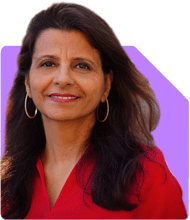Dr Hemalata Arora |169 Answers |Ask -Follow
General Physician - Answered on May 25, 2023
In a career spanning over 24 years, she has focused on managing infectious diseases, critical illnesses and lifestyle disorders.
Dr Arora completed her MBBS and MD from the King Edward Memorial Hospital and Seth Gordhandas Sunderdas Medical College in Mumbai.
She is ECFMG certified, accredited by the American Board of Internal Medicine, Diplomate of the National Board and a DNB faculty.
She was honoured with the Paul Bunn award for her promising performance in the field of infectious diseases at SUNY Upstate Medical University, New York.... more

Hello Doctor, my question is - can we reverse the diabeties.
You may like to see similar questions and answers below
Dr Rahul Baxi |31 Answers |Ask -Follow
Diabetologist - Answered on Apr 28, 2023
Komal Jethmalani |293 Answers |Ask -Follow
Dietician, Diabetes Expert - Answered on May 25, 2023
Komal Jethmalani |293 Answers |Ask -Follow
Dietician, Diabetes Expert - Answered on May 25, 2023
Samraat Jadhav |1682 Answers |Ask -Follow
Stock Market Expert - Answered on Apr 24, 2024
Samraat Jadhav |1682 Answers |Ask -Follow
Stock Market Expert - Answered on Apr 24, 2024
Ramalingam Kalirajan |784 Answers |Ask -Follow
Mutual Funds, Financial Planning Expert - Answered on Apr 24, 2024
Ramalingam Kalirajan |784 Answers |Ask -Follow
Mutual Funds, Financial Planning Expert - Answered on Apr 24, 2024
Ramalingam Kalirajan |784 Answers |Ask -Follow
Mutual Funds, Financial Planning Expert - Answered on Apr 24, 2024
Ramalingam Kalirajan |784 Answers |Ask -Follow
Mutual Funds, Financial Planning Expert - Answered on Apr 24, 2024
Ramalingam Kalirajan |784 Answers |Ask -Follow
Mutual Funds, Financial Planning Expert - Answered on Apr 24, 2024
Ramalingam Kalirajan |784 Answers |Ask -Follow
Mutual Funds, Financial Planning Expert - Answered on Apr 24, 2024
Ramalingam Kalirajan |784 Answers |Ask -Follow
Mutual Funds, Financial Planning Expert - Answered on Apr 24, 2024
Ramalingam Kalirajan |784 Answers |Ask -Follow
Mutual Funds, Financial Planning Expert - Answered on Apr 24, 2024























